North Cassiar Highway, B.C.
Lakes, rivers, streams, and creeks, from trickles to torrents, everywhere we look, seemingly uncountable. Hundreds of miles of endless forests, from the lime-green of the aspens to the deep emerald hues of the evergreens, reaching to the ends of the Universe. Abrupt, towering, brooding mounts of slate-gray rock, reaching up through tendrils of snow into the azure sky. For hour after hour, these are the entrancing views that greet us along the Cassiar Highway.
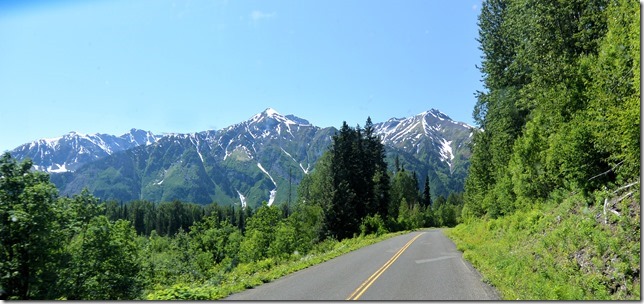
This highway is not a daisy-chain of breath-taking views. It is rather a fairy-tale wandering through the forests of time forgotten. It’s so easy to see this landscape as being the same way it was “back when”.
Sure, way in the back of my mind, I know that there is substantial logging throughout the area. Along the road, occasional clear-cuts are visible through a too-thin screen of un-cut trees. But the overall impression is still one of un-trammeled wilderness, true or not. From what I can see on our maps, it’s mostly true. Even the rugged logging roads are only faint intrusions into the vastness of the region.
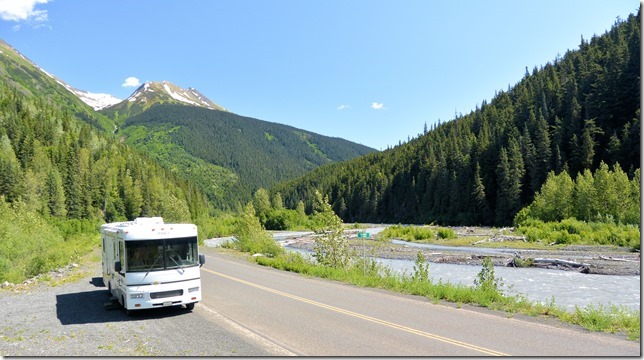
Townships almost do not merit the name. The tiny settlements along the way create hardly a blip in the sweep of the landscape. In fact, it’s a welcome sight to see a tiny enclave, ready to exchange some high-priced gasoline for our tourist dollars. Gas is up to almost $5/gallon (ouch) in the northern stretch of the highway, but with 50 or even 100 miles between services, it’s welcome at almost any price.
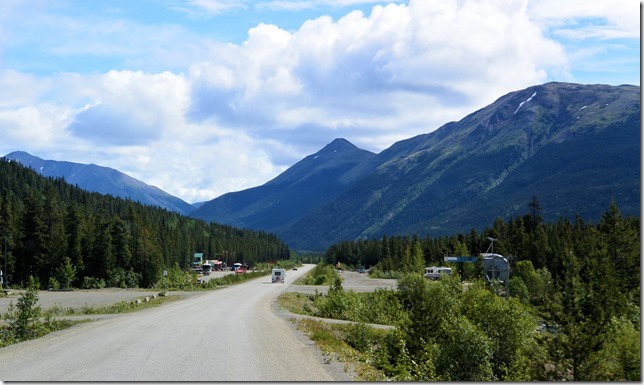
Many types of folks travel the Cassiar, from typical RV-ers like us to world-travelers in overland expedition vehicles like this Land Rover from the UK. This guy has been to more countries than we have States. We’re a little jealous – but we have a shower, heater, and toilet. So he can be jealous too.
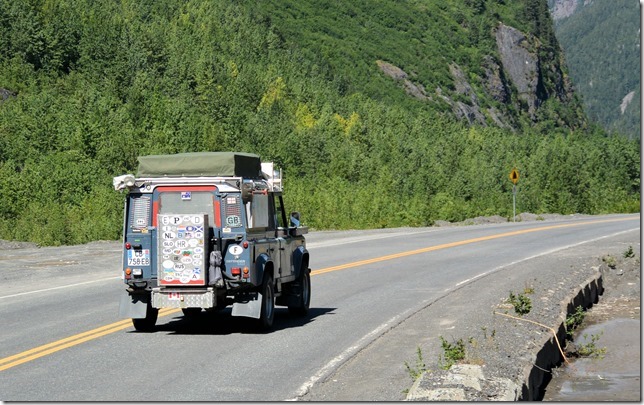
Sometimes, there’s evidence that the highway views can be a little too distracting. We can’t think of too many other reasons why this guy “parked” here. I guess alcohol could be on the list…
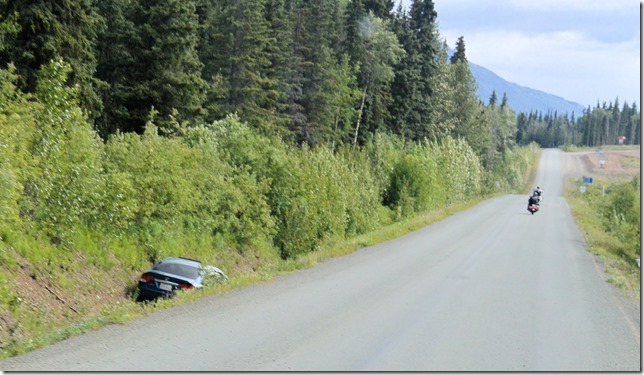
There is a big power-line project, marching north toward Dease Lake, and it makes no pretense of blending in with the countryside. (Let’s face it, there’s not much you can do to hide or disguise a 250KV transmission line.)
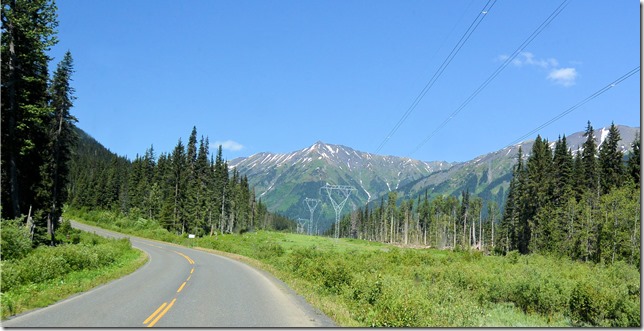
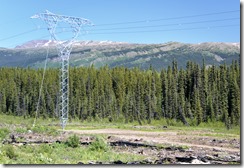
The transmission line construction is brand new, with construction happening as we drive by in fact. As such, the destruction along the right of way is fresh and mean, a razed landscape of dirt and debris. This will eventually grow in and be kept cropped to low brush, for a more friendly future appearance. Right now it’s pretty severe.
All that said, the terrain is so huge that the power line does not make much of an overall statement. Sure, it’s man’s footprint besmirching the wild, which we all would like to avoid or minimize. But honestly, it’s a small foot-print, and right next to the existing road at that. We were not unduly offended. Dease Lake has been running on diesel generators forever, and the power line will allow a few less tons of diesel exhaust to be spewed into the highway corridor.
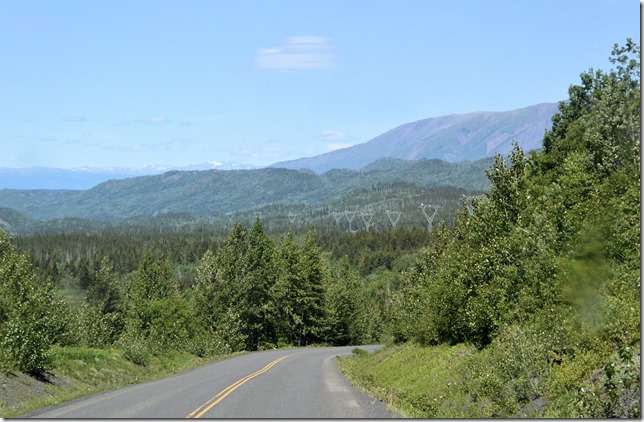
These huge slash piles, twenty feet high, were stacked up in the aftermath of cutting/clearing for the power line run. Somebody’s going to make some really BIG campfires one day.
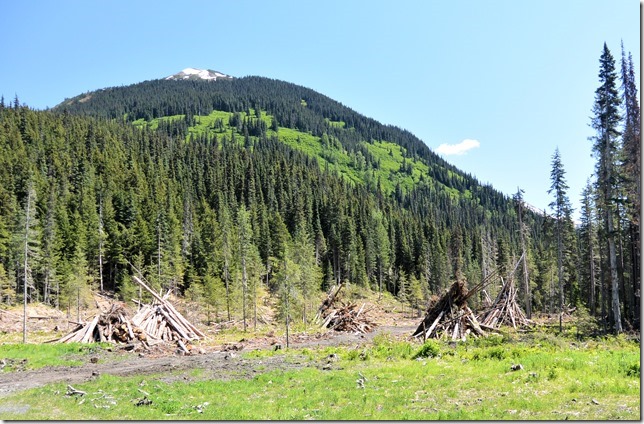
Speaking of campfires – – this time of year (shoulder season), there is also a grand selection of campgrounds to choose from. We haven’t yet elected to boondock in Canada, but there are ample opportunities; we are waiting to slow-down our trip, when we are further north, because scouting a proper boondock site (RV-accessible, legal and safe) can take some time.
Established RV sites are easy-access, quick and convenient. They are also frequent, much more-so than gas stations. The private sites often have wifi, although it’s typically of dubious quality. Public sites are either “recreation” sites (U.S. residents think “USFS or BLM camps”), of which there are few along the Cassiar, or Provincial Parks (U.S. residents think “state parks”). We’ve stayed at both, and our current preference is for the Provincials. They have few facilities (no wifi or power), but they’re cheaper and usually at great locations like lake-side or river-side. Prices are in the CA$20-$35 range.
The whole Cassiar corridor has an extraordinary supply of lakes and streams, and many of them have established camp sites. We have found these camps beatifically beautiful in fair weather or foul. For most of this week we have hop-scotched from lake to lake, cherry-picking fabulous camp sites right on the water’s edge. I’ve purposely taken a couple of snapshots through Howie’s windshield, just to show how close and comfy we are in these sites.
Kinaskan Lake (Provincial Park, CA$18), about halfway up the Cassiar Highway.
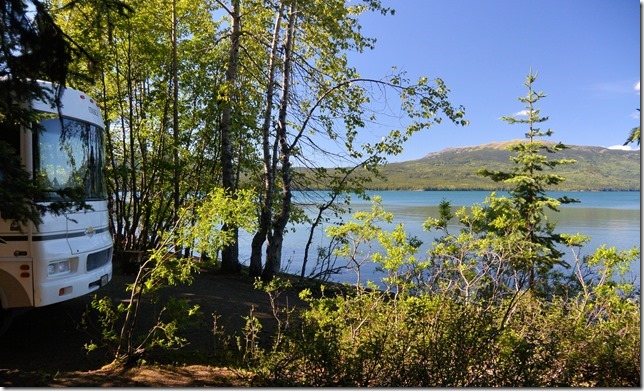
Dease Lake (southern end), Waters Edge private campground, CA$25.
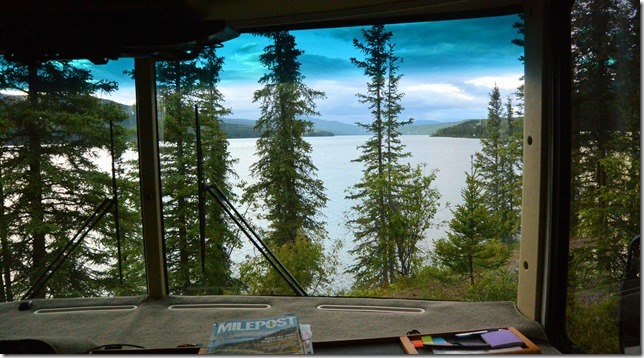
Boya Lake (Provincial Park, CA$20).
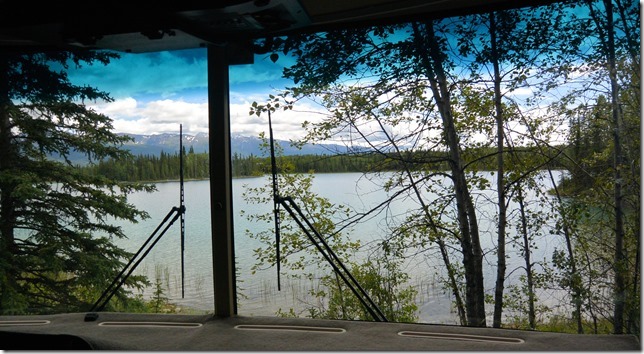
In every lake-side camp, there was a boat ramp, a boat dock, and easy shore-side access. During an incredible perfect-weather day on Kinaskan Lake, we puffed up our inflatable kayak “Bote” and put out on the water.
We hadn’t been in Bote in quite some time, and our technique and muscles were both in need of refurbishment – but we had an excellent afternoon. The lake surface was one of those perfect ripples (water-skiers will know what I mean – when you can feel the cut of your ski against the texture of the water). Bote skimmed cleanly and easily along the shoreline, with us waving our paddles at the occasional camper who looked up at us.
This is Howie, nestled in the woods at water’s edge.
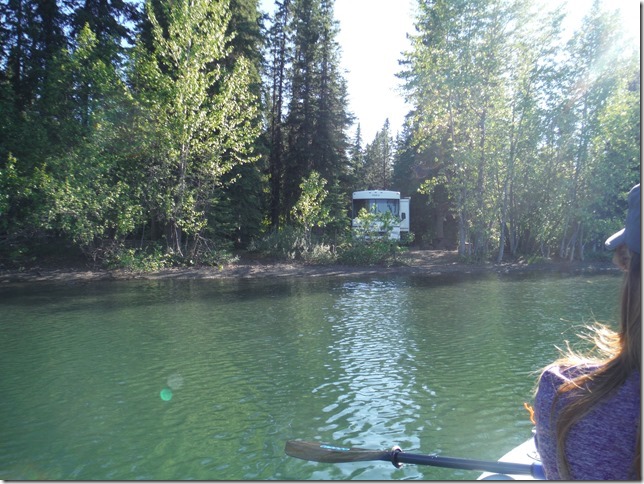
Here’s a strange rig in a nearby campsite, brought down off a pickup-truck’s makeshift wooden roof-rack. It’s “prototype A” according to some self-proclaimed rednecks from the Michigan upper peninsula. I told them I’d take some pictures we could show the Mounties when they didn’t come back. Good humored bunch of guys. They actually tried it out a bit later in the evening.
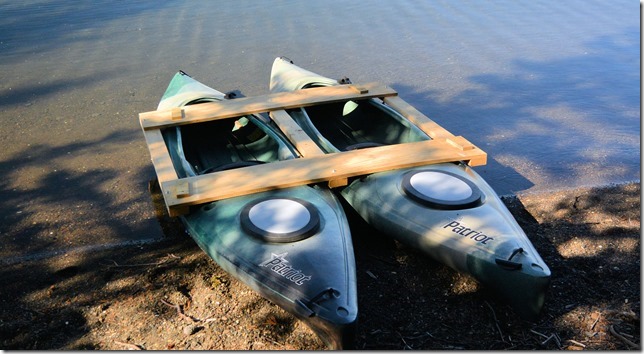
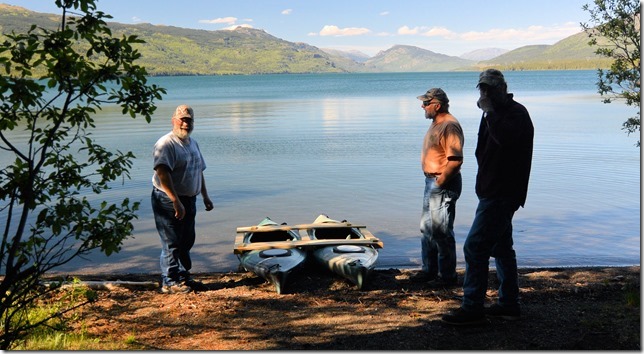
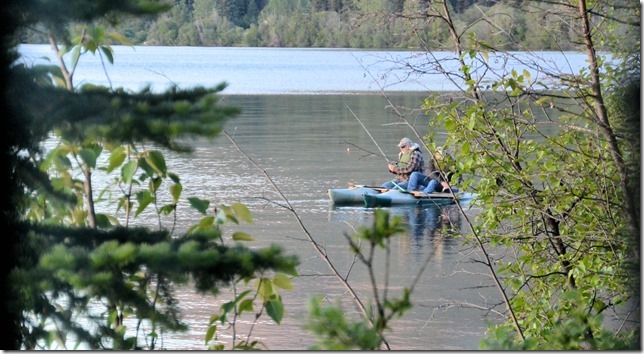
Every place we stayed had little local trails to explore, pleasant strolls through the woodsy shorelines or along the edges of the camps. These are so nice for our “constitutional” walks, which we do two or three times a day. Here’s the shoreline trail at Kinaskan Lake.
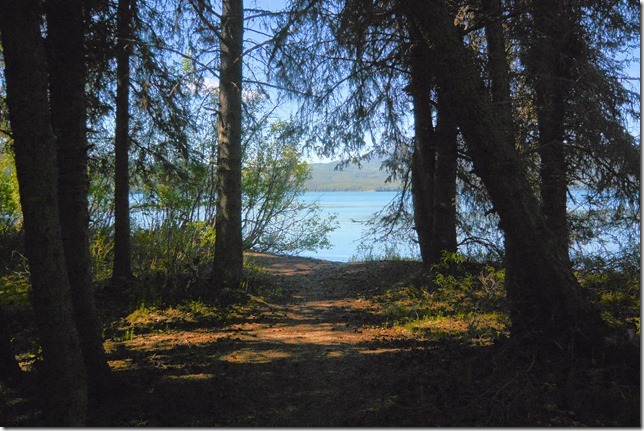
And then there are the little things. Tiny delights that teach you to slow down, open your eyes and look around you. These miniscule forest wildflowers are hardly a centimeter across, but their diminutive size only enhances their beauty.
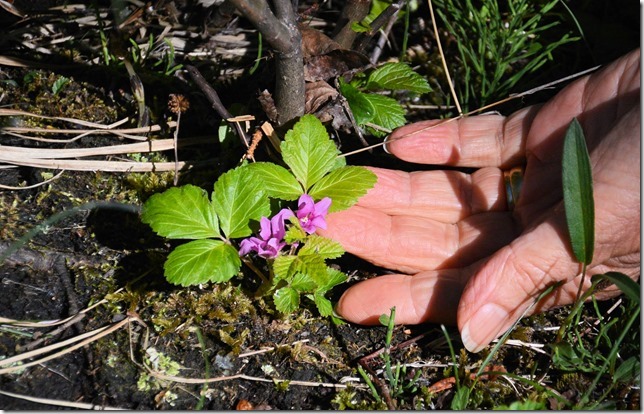
Wildlife is plentiful in the area, but not like we were in Yellowstone Park or such. We’ve seen the occasional road-side bear and moose, and once a red fox. But this is a huntable area, and the animals aren’t very keen on staying around humans for long.
A roadside bear, munching on salmon-berries, couldn’t care less for us.
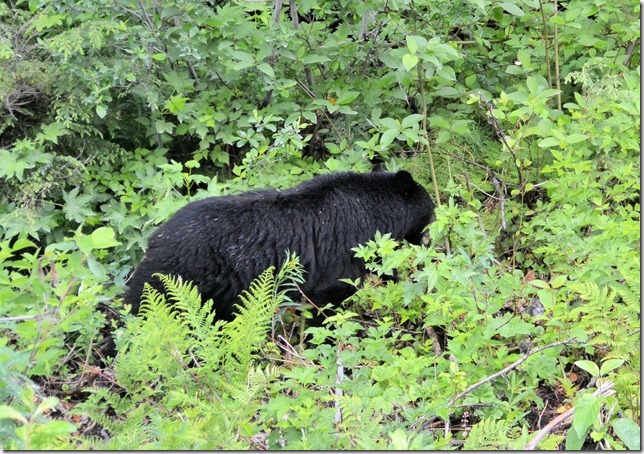
But this (side-road) moose just wanted out of town, pronto.
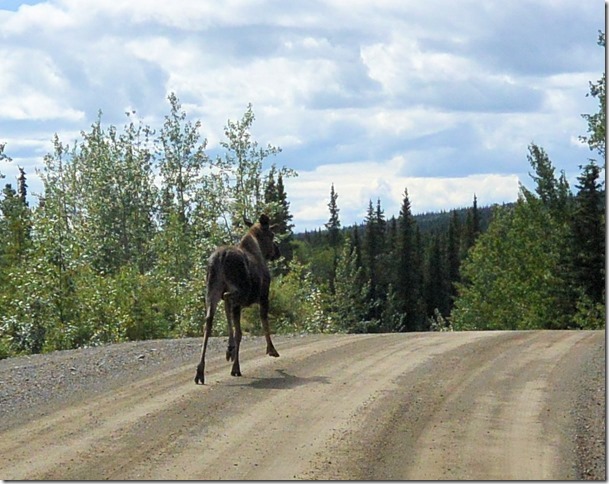
And the red fox wasn’t willing to pose until almost hidden.
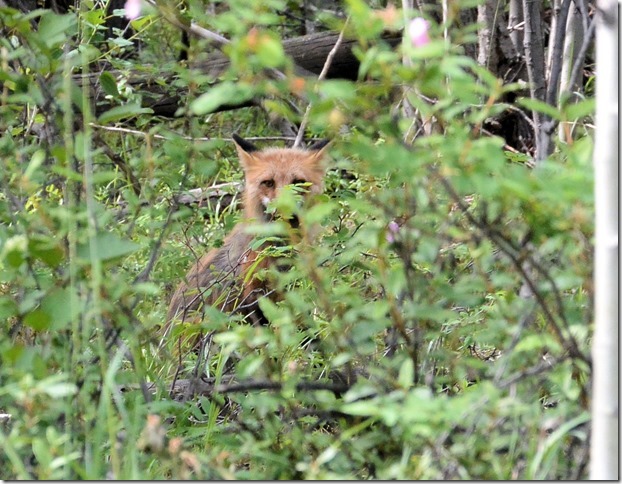
Most of the settlements along the Cassiar are, largely, working towns. Not too much tourist-stuff aside from RV parks, tiny gift shops and souvenir T-shirts. But at Jade City, this changes. This “town” is actually a 50-man company that mines and sells jade. Most of the stuff is typical crank-em-out fodder, but worthy souvenirs nonetheless. They also have some larger pieces, and some interesting one-off stuff here and there. [Oddly enough, stone-carving is not a Native talent, and as such the objet d’ art are crafted elsewhere, typically in Asian countries where such talents are more routinely found.]
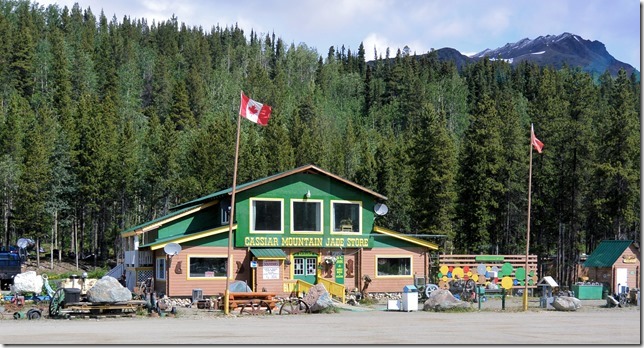
Pink and green jade faucet handles, and a sequence of the cutting/carving process.
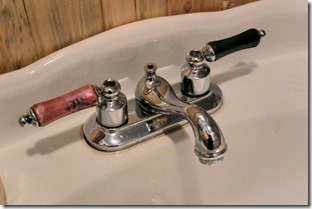
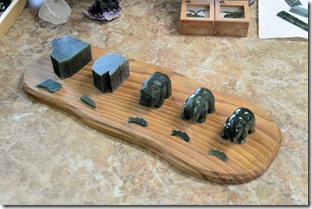
Out back, I spied an interesting project – a big diesel 4×4 truck being outfitted with massive traction tires. I stopped and jokingly asked what they’d charge me to mount a set on Ralph.
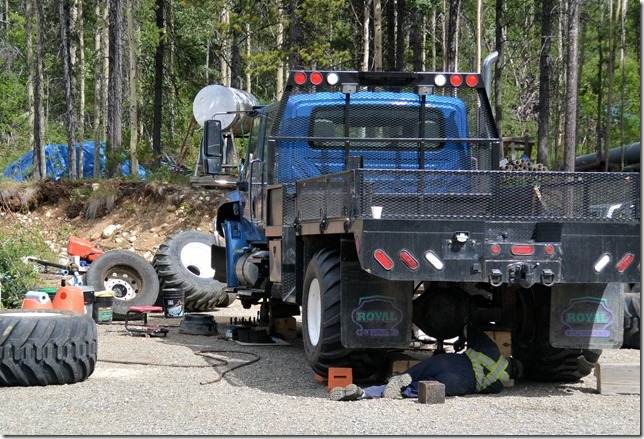
Turns out, they’re building this truck for working transportation back to the jade mine – 80 long miles out into the back country. This rig will eventually hold six guys and a few tons of mining gear and provisions, for a ten-hour grind over huge potholes and muddy ruts. I wondered out loud whether they could travel during winter, but it turns out that they can only mine during the summer. The cutting blades used to mine the jade need water to work – so the first freeze sends everyone packing for the season. The store is open year-round, but it’s clear their bread-and-butter is summertime. True along most of the Cassiar.
As we departed Jade City, we spotted this young couple at the edge of the free-parking area. They had a bunch of stuff hung on a drying line – but it was raining, and they were hauling it all in and packing it up post-haste. They had a lot of gear, and I’ll guess they were packing 50-60 pounds apiece as they prepared to continue cycling up and down the hills of the Cassiar Highway. Don’t know where they’re headed, but good luck to them.
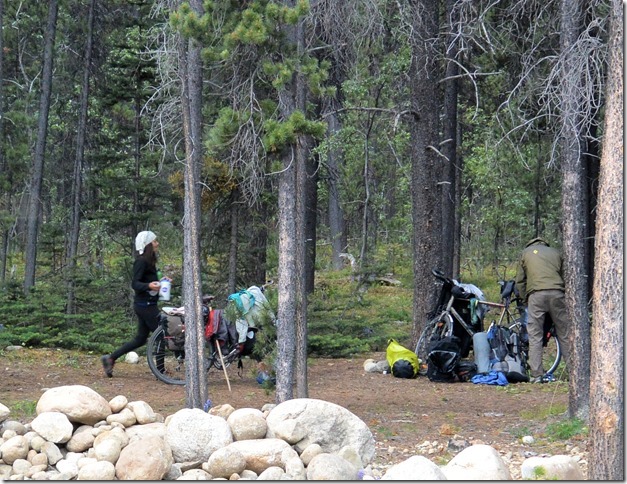
Like I said, we have a shower, heater, toilet, and yes a Queen-sized bed.
Later in the evening, after we make camp (on yet another lake shore), the day blesses us with a fabulous double rainbow.
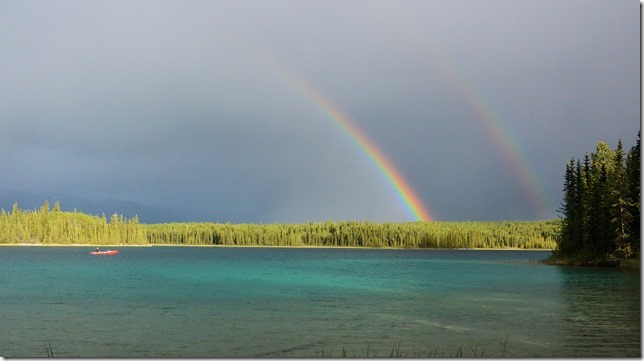
Spoiled rotten we are. Life is good.
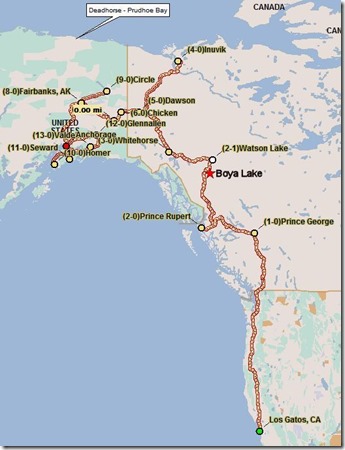 Miles driven (Howie): 2,890
Miles driven (Howie): 2,890- Miles driven (Ralph): 774
- Days traveling: 27
- Miles from home: 2,099

Beautiful. Where are the Totem poles?
That double rainbow knocks my socks off! We were planning on doing something similar to you folks last year, but my husband is a teacher, so I don’t think 2 months would do it justice, do you?
Two months is plenty to make a dent. Many visits still won’t see it all.
All I can say is wow! I just want to be there! Thanks again.